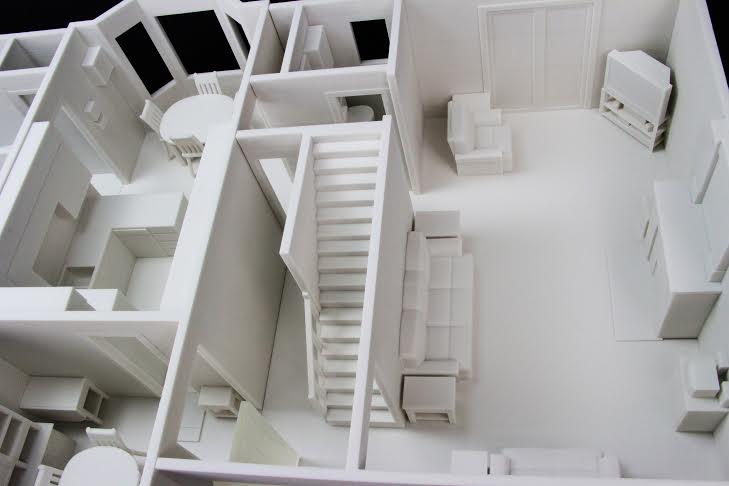Charges Dismissed! Whiteclouds Creates 3D Printed Replica of Murder Home for Stiffler Trial in Shooting of Montana Burgler
 When it comes to protecting themselves, many have a very simple attitude—initially. You become concerned about crime in your city or town and you don’t want to be left defenseless, so you buy a gun. Or two. Or in some cases, a treasure trove. In order not to be left bringing the proverbial pathetic knife to a gunfight, you become educated in how to use your weapon, and you might even be ready for a confrontation—after all, you’ve worked so hard to shield yourself from imagined criminals. So, when someone really does break into your house, it’s on. Adrenaline is pumping. Is there any doubt that you are not going to shoot someone who has broken into your private realm and most likely wants to hurt you and perhaps has the intention of taking your life–not to mention your stuff?
When it comes to protecting themselves, many have a very simple attitude—initially. You become concerned about crime in your city or town and you don’t want to be left defenseless, so you buy a gun. Or two. Or in some cases, a treasure trove. In order not to be left bringing the proverbial pathetic knife to a gunfight, you become educated in how to use your weapon, and you might even be ready for a confrontation—after all, you’ve worked so hard to shield yourself from imagined criminals. So, when someone really does break into your house, it’s on. Adrenaline is pumping. Is there any doubt that you are not going to shoot someone who has broken into your private realm and most likely wants to hurt you and perhaps has the intention of taking your life–not to mention your stuff?
In the case of James George Stiffler, he was armed and ready as he approached his home in Helena, MT, on May 22, 2013. He—one way or another–shot and killed the very unlucky intruder, who Stiffler contended ransacked his home and threatened him as he walked in.
Stiffler was charged with felony deliberate homicide, and a trial ensued, with the prosecution alleging that Henry Thomas Johnson was attempting to flee the scene and was climbing out of a window at the time that Stiffler shot him in the back. Stiffler’s account varied, as he basically said that Johnson met him in a different part of the house, moved sideways from a bullet, escaped through the window, and then more violence occurred outside as Johnson got in his car and attempted to drive away with Stiffler firing more shots. The only bullet found was in the driveway, and it did have Johnson’s DNA on it, but it was believed that perhaps it exited his body and fell in the driveway as he was jumping out the window.One can see how confusing the events and accounts were, and why there would need to be some pretty detailed help for all to navigate around the property in a virtual manner. Most of us are well aware that these types of ‘crimes’ and trials are tricky, and the public usually has a lot to say. In this case, Stiffler had technology on his side—and in no time, the majority of the jurors too.
At the request of defense attorney Quentin Rhoades, Utah-based Whiteclouds made an architectural model of Stiffler’s floor plan. While this might seem like a good idea for any trial where they were trying to establish the whereabouts of the crime and each of the people involved, it was particularly helpful here due to maze-like features of the Stiffler home, and using 3D printing cost about one-third of the price that the court would have paid to hire an architect to produce a model.
The Whiteclouds team was able to scale the model using exact floorplans, as well as exact measurements from the Stifflers’ furniture, which was placed in the proper locations within the model.
After receiving over 300 images of the home’s interior, the Whiteclouds team was able to create an exact replica, modeled in Maya. After that, the 3D print was fabricated on a ProJet 860Pro using sandstone, except for the front door, which actually opened and closed—and was made with a plastic material out of UV-cured resin. They used 2,105 layers of sandstone, and the replica showed the finest details, even where “doggie gates” had been tripped. The Whiteclouds team states that the topography around the home was crucial to the case as well, so they also included this in the model.
The outcome of the trial, with this evidence in jurors’ hands, was that the county attorney filed a motion to dismiss the charges upon seeing that the jury was deadlocked and only two jurors were actually in favor of convicting Stiffler. Was this 3D model a tipping point for the jurors? Being able to walk around the house in their minds certainly helped give a better visual–and no doubt, with the complicated layout of the home, indeed Stiffler’s case did heavily rest on that point.
Model Stats:
- Color: White
- Dimensions: 784 x 214 x 508 mm
- Total Volume of Material: 7,725.26 cm3
- Number of Layers: 2,105
- Printers: ProJet 860Pro, for the entire model except the front door. ProJet 3500 for working front door.
- Materials: Model is sandstone-like material. Front door is UV-cured resin.
Whiteclouds is a company that we report on often, as the world’s largest full-color 3D print services provider. We have followed them through their evolution as a company, as they’ve expanded and worked on some very exciting projects large in scope. Thoughts on how technology may have helped this case? Discuss in the 3D Printed Stiffler Home forum over at 3DPB.com.
Subscribe to Our Email Newsletter
Stay up-to-date on all the latest news from the 3D printing industry and receive information and offers from third party vendors.
You May Also Like
Further Understanding of 3D Printing Design at ADDITIV Design World
ADDITIV is back once again! This time, the virtual platform for additive manufacturing will be holding the first-ever edition of ADDITIV Design World on May 23rd from 9:00 AM –...
3D Printer Maker EVO-tech Reborn as NEVO3D — Once More With Feeling
EVO-tech was a 3D printing service and original equipment manufacturer established in 2013 and based in Schörfling am Attersee, Austria. The company produced high-quality material extrusion systems featuring linear bearings,...
3D Systems Brings 3D Printed PEEK Cranial Implant to the U.S. with FDA Clearance
For more than 10 years, 3D Systems (NYSE:DDD) has worked hand-in-hand with surgeons to plan over 150,000 patient-specific cases, and develop more than two million instruments and implants from its...
CDFAM Returns to Berlin for Second Annual Symposium
The second CDFAM Computational Design Symposium is scheduled for May 7-8, 2024, in Berlin, and will convene leading experts in computational design across all scales. Building upon the first event...


































